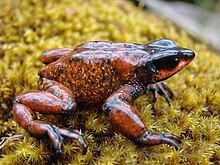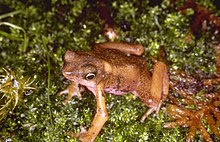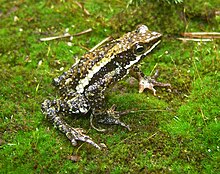Stumpy foot frogs
| Stumpy foot frogs | ||||||||||||
|---|---|---|---|---|---|---|---|---|---|---|---|---|

Panama stubby frog ( Atelopus zeteki ) |
||||||||||||
| Systematics | ||||||||||||
|
||||||||||||
| Scientific name | ||||||||||||
| Atelopus | ||||||||||||
| Duméril & Bibron , 1841 |
The stump foot frogs ( Atelopus ) are sometimes also called harlequin frogs or harlequin toads and form a genus of the toad family (Bufonidae) that is native to tropical Latin America - between Costa Rica in the north and Bolivia in the south . Currently about 96 described species are counted among these amphibians - some more former Atelopus species are now assigned to other genera. In older systematics, the stump foot frogs and the saddle toads ( Brachycephalus ) were separated as a separate family Atelopidae. Among other things, the presence of the Bidders organ shows them to be a member of the "toads".
description
They are mostly very small, slim and sometimes bizarre, very colorful and poisonous frogs (see for example: Panama stumpy frog ). The German name refers to the often shortened inner fingers and toes.
The pupil is horizontal. The tongue is elliptical, with entire margins and freely liftable at the back. There are no teeth or folds of the palate. The eardrum is not visible. The fingers are either free or connected at the base by means of a web of webs. This does not intervene between the metatarsi of the 4th and 5th toes. The tips of the fingers and toes are at most slightly thickened, but never widened into clear adhesive discs. The end links of the toes are simple and bony. The coracoid and precoracoid diverge more or less strongly. The omosternum is absent. The sternum is cartilaginous. The transverse processes of the sacral vertebra are moderately widened.
Way of life
Their preferred habitats include gorges of mountain cloud forests . They stay there on the ground and are usually active during the day on the hunt for insects and other small invertebrates . Hikes to spawning grounds in fast-flowing mountain streams and small rivers can bring stubby-footed frogs to mating for weeks or even months . The males of many species utter soft trilling or chirping courtship calls. The spawn is laid in strings and attached to plants or stones in the water. The tadpoles have large suction cups to prevent them from drifting in the currents of the streams.
species

The genus includes 97 species.
As of August 18, 2020
- Atelopus andinus Rivero , 1968
- Atelopus angelito Ardila-Robayo & Ruiz-Carranza , 1998
- Atelopus ardila Coloma , Duellman , Almendáriz , Ron , Terán-Valdez & Guayasamin , 2010
- Atelopus arsyecue Rueda-Almonacid , 1994
- Atelopus arthuri Peters , 1973
- Atelopus balios Peters , 1973
- Atelopus barbotini Lescure , 1981
- Atelopus bomolochos Peters , 1973
- Atelopus boulengeri Peracca , 1904
- Atelopus carauta Ruiz-Carranza & Hernández-Camacho , 1978
- Atelopus carbonerensis Rivero , 1974
- Atelopus carrikeri Ruthven , 1916
- Atelopus certus Barbour , 1923
- Atelopus chiriquiensis Shreve , 1936
- Atelopus chirripoensis Savage & Bolanos , 2009
- Atelopus chocoensis Lötters , 1992
- Atelopus chrysocorallus La Marca , 1996
- Atelopus coynei Miyata , 1980
- Atelopus cruciger ( Lichtenstein & Martens , 1856)
- Atelopus dimorphus Lötters , 2003
- Atelopus Ebenoides Rivero , 1963
- Atelopus elegans ( Boulenger , 1882)
- Atelopus epikeisthos Lötters , Schulte & Duellman , 2005
- Atelopus erythropus Boulenger , 1903
- Atelopus eusebianus Rivero & Granados-Díaz , 1993
- Atelopus eusebiodiazi Venegas , Catenazzi , Siu-Ting & Carrillo , 2008
- Atelopus exiguus ( Boettger , 1892)
- Atelopus famelicus Rivero & Morales , 1995
- Atelopus farci Lynch , 1993
- Atelopus flavescens Duméril & Bibron , 1841
- Atelopus franciscus Lescure , 1974
- Atelopus galactogaster Rivero & Serna , 1993
- Atelopus gigas Coloma , Duellman , Almendáriz , Ron , Terán-Valdez & Guayasamin , 2010
- Atelopus glyphus Dunn , 1931
- Atelopus guanujo Coloma , 2002
- Atelopus guitarraensis Osorno-Muñoz , Ardila-Robayo & Ruiz-Carranza , 2001
- Atelopus halihelos Peters , 1973
- Atelopus hoogmoedi Lescure , 1974
- Atelopus ignescens ( Cornalia , 1849)
- Atelopus laetissimus Ruiz-Carranza , Ardila-Robayo & Hernández-Camacho , 1994
- Atelopus limosus Ibáñez , Jaramillo & Solís , 1995
- Atelopus loettersi De la Riva , Castroviejo-Fisher , Chaparro , Boistel & Padial , 2011
- Atelopus longibrachius Rivero , 1963
- Atelopus longirostris Cope , 1868 ( † )
- Atelopus lozanoi Osorno-Muñoz , Ardila-Robayo & Ruiz-Carranza , 2001
- Atelopus lynchi Cannatella , 1981
- Atelopus manauensis Jorge , Ferrão & Lima , 2020
- Atelopus mandingues Osorno-Muñoz , Ardila-Robayo & Ruiz-Carranza , 2001
- Atelopus marinkellei Cochran & Goin , 1970
- Atelopus mindoensis Peters , 1973
- Atelopus minutulus Ruiz-Carranza , Hernández-Camacho & Ardila-Robayo , 1988
- Atelopus mittermeieri Acosta-Galvis , Rueda-Almonacid , Velásquez-Álvarez , Sánchez-Pacheco & Peña Prieto , 2006
- Atelopus monohernandezii Ardila-Robayo , Osorno-Muñoz & Ruiz-Carranza , 2002
- Atelopus mucubajiensis Rivero , 1974
- Atelopus muisca Rueda-Almonacid & Hoyos , 1992
- Atelopus nahumae Ruiz-Carranza , Ardila-Robayo & Hernández-Camacho , 1994
- Atelopus nanay Coloma , 2002
- Atelopus nepiozomus Peters , 1973
- Atelopus nicefori Rivero , 1963
- Atelopus nocturnus Bravo-Valencia & Rivera-Correa , 2011
- Atelopus onorei Coloma , Lötters , Duellman & Miranda-Leiva , 2007
- Atelopus orcesi Coloma , Duellman , Almendáriz , Ron , Terán-Valdez & Guayasamin , 2010
- Atelopus oxapampae Lehr , Lötters & Lundberg , 2008
- Atelopus oxyrhynchus Boulenger , 1903
- Atelopus pachydermus ( Schmidt , 1857)
- Atelopus palmatus Andersson , 1945
- Atelopus pastuso Coloma , Duellman , Almendáriz , Ron , Terán-Valdez & Guayasamin , 2010
- Atelopus patazensis Venegas , Catenazzi , Siu-Ting & Carrillo , 2008
- Atelopus pedimarmoratus Rivero , 1963
- Atelopus peruensis Gray & Cannatella , 1985
- Atelopus petersi Coloma , Lötters , Duellman & Miranda-Leiva , 2007
- Atelopus petriruizi Ardila-Robayo , 1999
- Atelopus pictiventris Kattan , 1986
- Atelopus pinangoi Rivero , 1982
- Atelopus planispina Jiménez de la Espada , 1875
- Atelopus podocarpus Coloma , Duellman , Almendáriz , Ron , Terán-Valdez & Guayasamin , 2010
- Atelopus pulcher ( Boulenger , 1882)
- Atelopus pyrodactylus Venegas & Barrio , 2005
- Atelopus quimbaya Ruiz-Carranza & Osorno-Muñoz , 1994
- Atelopus reticulatus Lötters , Haas , Schick & Böhme , 2002
- Atelopus sanjosei Rivero & Serna , 1989
- Atelopus seminiferus Cope , 1874
- Atelopus senex Taylor , 1952
- Atelopus sernai Ruiz-Carranza & Osorno-Muñoz , 1994
- Atelopus simulatus Ruiz-Carranza & Osorno-Muñoz , 1994
- Atelopus siranus Lötters & Henzl , 2000
- Atelopus sonsonensis Vélez-Rodriguez & Ruiz-Carranza , 1997
- Atelopus sorianoi La Marca , 1983
- Atelopus spumarius Cope , 1871
- Atelopus spurrelli Boulenger , 1914
- Atelopus subornatus Werner , 1899
- Atelopus tamaense La Marca , García-Pérez & Renjifo , 1990
- Atelopus tricolor Boulenger , 1902 - three-colored stubby frog
- Atelopus varius ( Lichtenstein & Martens , 1856)
- Atelopus vermiculatus McDiarmid , 1973 ; is partly as a subspecies of A. flavescens viewed
- Atelopus vogli Müller , 1934 ( † )
- Atelopus walkeri Rivero , 1963
- Atelopus zeteki Dunn , 1933 - Panama stubby frog
Danger
Stubby-footed frogs have recently become sadly known that almost all species are acutely endangered in their continued existence: the IUCN classifies 61 of 94 assessed species in the highest endangerment category "critically endangered", and two species are considered safe "extinct" (extinct). According to a study from 2005, 42 of the 113 species described at the time showed a clear decrease in abundance, 30 species were assessed as missing. Only 10 species were considered stable in their population. The species Atelopus balios is now even counted by the IUCN among the hundred most critically endangered species.
The massive decline in stump foot frogs, among other causes, is primarily attributed to infections by the chytrid fungus ( Batrachochytrium dendrobatidis ), especially in the populations in Central America. Investigations in turn associate its increased occurrence with the onset of climate change . Increased cloud formation over the mountain habitats is said to lead to higher average temperatures in the nights, which means that the optimal temperature range for the chytrid fungus to thrive expands.
Mass exports to the western industrialized countries, where these amphibians were kept in terrariums, are likely to have contributed to the decline - often with little success and correspondingly high "animal consumption".
Sources and further information
Individual evidence
- ^ A b Darrel R. Frost: Atelopus Duméril & Bibron, 1841 . In: Amphibian Species of the World: an Online Reference. Version 6.0. American Museum of Natural History, New York 1998-2017, accessed February 5, 2018.
- ^ Fritz Nieden: Anura II. In: FE Schulze, W. Kükenthal, K. Heider (Ed.): The animal kingdom. Walter de Gruyter & Co., Berlin / Leipzig 1926, p. 76.
- ↑ a b P.J. Venegas, A. Catenazzi, K. Siu-Ting & J. Carrillo: Two new harlequin frogs (Anura: Atelopus) from the Andes of northern Peru , in: Der Salamander (translation of Salamandra), Volume 44, Book 3, p. 163-176, Rheinbach August 20, 2008. ISSN 1860-6644
- ↑ https://www.iucnredlist.org/species/54511/87542009 The IUCN Red List of Threatened Species - Atelopus flavescens = Atelopus vermiculatus
- ↑ La Marca et al. : Catastrophic Population Declines and Extinctions in Neotropical Harlequin Frogs (Bufonidae: Atelopus) , Biotropica 37 (2005): 190-201 PDF online ( Memento of the original from January 8, 2009 in the Internet Archive ) Info: The archive link was automatically inserted and not yet checked. Please check the original and archive link according to the instructions and then remove this notice.
- ↑ IUCN information sheet on the 100 most critically endangered species, engl.
- ↑ Study in " Nature ", quoted in in: Philip Bethge: An ark for the frogs. - DER SPIEGEL 47/2006: pp. 176–178.
literature
- Rainer Schulte: frogs and toads. Ulmer-Verlag, Stuttgart 1980, ISBN 3-8001-7048-5 .
Web links
- Atelopus in the IUCN Red List of Threatened Species2009. (Engl.)
- Darrel R. Frost: Atelopus Duméril & Bibron, 1841 . In: Amphibian Species of the World: an Online Reference . Version 6.0. American Museum of Natural History, New York 1998-2017, accessed February 5, 2018
- Amphibiaweb: List of species of the family Bufonidae (Engl.)
- Boy finds 'extinct' frog in Ecuador and helps revive species - Atelopus ignescens








